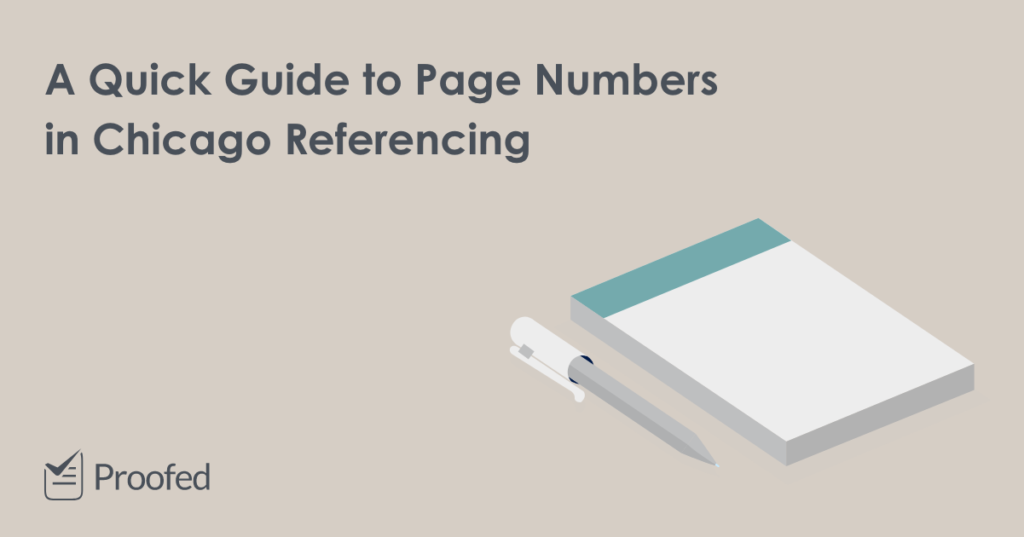Chicago referencing is widely used in academic writing. It has various rules for how and when to use page numbers. And it’s worth knowing these rules if you’re been asked to use Chicago style in your work. In this post, then, we’ll look at how to write page numbers in Chicago referencing.
Arabic vs. Roman Numerals
Generally, Chicago referencing requires you to use Arabic numerals (e.g., 1, 2, 3) instead of Roman numerals (e.g., i, ii, iii) for page numbers.
Roman numerals should only be used in Chicago referencing for the front matter of books, and only then if the source itself uses Roman numerals.
When to Use “P.” and “Pp.”
You should give page numbers in Chicago author–date and footnote references when you quote a print source directly. Page numbers are also required in a Chicago bibliography for a source within a container, such as a journal article or a chapter from an edited book.
In most cases, you can give page numbers by themselves. For instance:
1. W.B. Yeats, Collected Poems (New York: Scribner, 1996), 123.
Here, we’re citing page 123 from a book. We know it is a page number because it comes at the end of a citation for a book and it is the only locator (i.e., something to pinpoint the part of the source cited) included.
However, the Chicago Manual of Style suggests using abbreviations for page (p.) and pages (pp.) when needed for clarity. Thus, if you give another number in a citation or footnote, such as a line number, you should add “p.” or “pp.” before the page number(s). For example:
2. W.B. Yeats, Collected Poems (New York: Scribner, 1996), p. 123, lines 12–14.
Here, labelling the page number with “p.” and the line numbers with “lines” helps to prevent confusion. But you only need to use “p.” and “pp.” when giving page numbers alone could be ambiguous.
Page Ranges in Chicago Referencing
If you are referring to more than one page in a source, Chicago referencing has rules on how to present them. The rules for formatting an inclusive range of pages are outlined in the table below:
|
First number |
Second number |
Examples |
|
|
|
|
|
100 or multiples of 100 |
Use all digits |
100–104 |
|
101 through 109, |
Use changed part only |
101–8 |
|
110 through 199, |
Use two digits unless more are needed to include all changed parts |
321–28 |
The exception to these rules is if you are using an inclusive range of Roman numerals, when you should always give them in full (e.g., “cxi–cxviii”).
Find this useful?
Subscribe to our newsletter and get writing tips from our editors straight to your inbox.
For non-consecutive pages, meanwhile, separate numbers with commas:
We see this in more than one poem (Yeats, 1996, 24, 27).
Here, we’re citing pages 24 and 27, but not the intervening ones.
Sources Without Page Numbers
Some electronic sources, such as websites, don’t have page numbers. And for others, such as ebooks, the page numbering may depend on the format. Consequently, Chicago referencing doesn’t necessarily require you to give a pinpoint citation for sources without page numbers.
However, for longer or more complex documents where it could be hard to find an exact quote without a pinpoint citation, it is worth using an alternative locator if you can, such as a paragraph or chapter number.
Here are examples of how this could look in footnote references:
3. “William Butler Yeats,” Poetry Foundation, para. 4, accessed October 13, 2020, https://www.poetryfoundation.org/poets/william-butler-yeats.
4. W.B. Yeats, Fairy Tales of Ireland (New York: Harper Collins, 2019), chap. 7, Kindle.
These locators will help readers to find the part of the source you’ve cited.
Expert Chicago Referencing Proofreading
Hopefully, this post has helped to explain some of the key aspects of using page numbers in Chicago referencing. But if you would like an expert to check the referencing in your document for errors, or any other aspect of your writing, you can try our proofreading service for free today!
